Sumeru Altar, the Essence of
Buddhist Woodcraft
Text by. Noh Seung-dae Photo by. Ha Ji-kwon
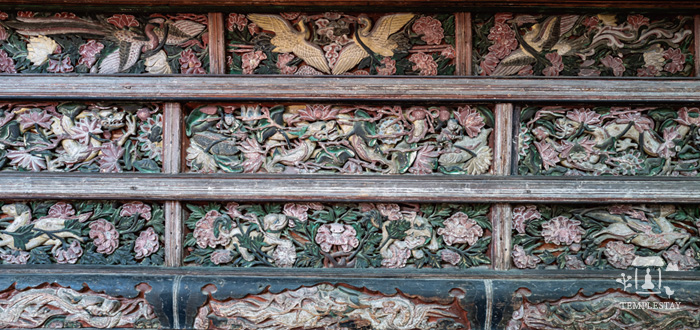 The Sumidan in Geungnakjeon Hall at Baekheungam Hermitage can be said to be the essence of Buddhist woodcraft
The Sumidan in Geungnakjeon Hall at Baekheungam Hermitage can be said to be the essence of Buddhist woodcraft
Spring has arrived. All things come to life in spring. The forest stretches out its branches, and flowers bloom as if competing with each other. In a forest full of life, all kinds of animals run about energetically. The light of spring has come to the temple compound too. The temple is also a place where flowers bloom all year round. I am speaking of the Sumeru altar (Sumidan in Korean). All kinds of living things are depicted playing and frolicking on Sumidan among the carefully trimmed and carved flowers. It's like a celebration of life on a gorgeous spring day.
Crafted from wood, Sumidan holds the incense burners and candlesticks necessary for Buddhist rituals as well as offerings from devotees. Because it is an altar that enshrines buddhas, it is also called a buddha altar. In Buddhist mythology, above Mt. Sumeru is the realm of heaven. This buddha altar is called Sumidan because it depicts the Buddha giving a teaching to all living beings from the summit of Mt. Sumeru, the highest mountain on Earth.
During the Silla and Goryeo periods, the Buddha was often enshrined on a stone pedestal in the center of a temple. The octagon-shaped pedestal was carved with lotus flowers on the upper and lower levels and was narrow in the middle, commonly called a lotus pedestal. Mt. Sumeru is also narrow in the middle and wide at the top and bottom. Therefore, this lotus pedestal is also called a Sumeru pedestal. Sumidan has the same symbolic meaning, so the middle part, also decorated with carvings, is somewhat narrow.
During the Goryeo Dynasty, wooden pedestals for buddha statues also appeared.
Although some of them were featured in Goryeo Buddhist paintings, only one has been preserved intact: the wooden hexagonal Sumidan in Daeungjeon Hall at Sudeoksa Temple. The Daeungjeon (main buddha hall; national treasure) at Sudeoksa Temple was built in 1308 during the late Goryeo Dynasty and is the largest of the five Goryeo-era buildings in Korea. Among the three buddhas enshrined in the buddha hall, the pedestal of Shakyamuni Buddha in the center is the wooden hexagonal Sumidan from the Goryeo Dynasty.
A hexagonal foundation stone sits beneath the wooden hexagonal Sumidan. At the time the pedestal was crafted, a hexagonal foundation stone was set in place, and a wooden Sumidan was crafted on top of it. The decorative carving on the wooden Sumidan is in the same style as the Buddhist altar in Bogwangjeon Hall of Simwonsa Temple, located on Mt. Jabisan in Hwanghae Province, North Korea. This Bogwangjeon Hall was rebuilt in 1372 by Yi Saek after seeing the temple in decline. Here, the Sumidan was rebuilt in a rectangular, two-tier style.
The three buddhas on the Sumidan were enshrined side by side on the upper tier, and ceremonial utensils like incense burners and candle holders were placed on the lower tier. The decorative designs carved on this altar included vajra, vases with flowers, peonies, and cloud patterns, and are the same as the carvings on the wooden Sumidan at Sudeoksa Temple. It is a direct continuation of the Goryeo style. In addition, it can be seen that toward the end of the Goryeo Dynasty, the buddha pedestals and the table on which offerings were placed were evolving into an integrated form.
In addition, short arrow-shaped designs, depicted inverted, are carved above the flower vases on all six sides of the pedestal. They resemble the red arrows commonly seen at Hongsalmun (lit. “gate of red arrows”), but here they are depicted upside down.
These red arrows also play a role in protecting the Buddha, just as they protect the royal tombs. These red arrows can also be found on the Sumidan at Muryangsujeon Hall (national treasure) of Buseoksa Temple in Yeongju, a Goryeo Dynasty building.
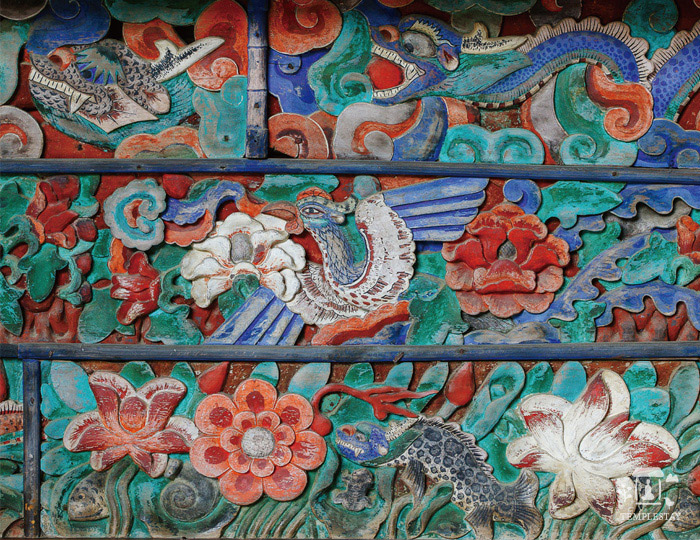
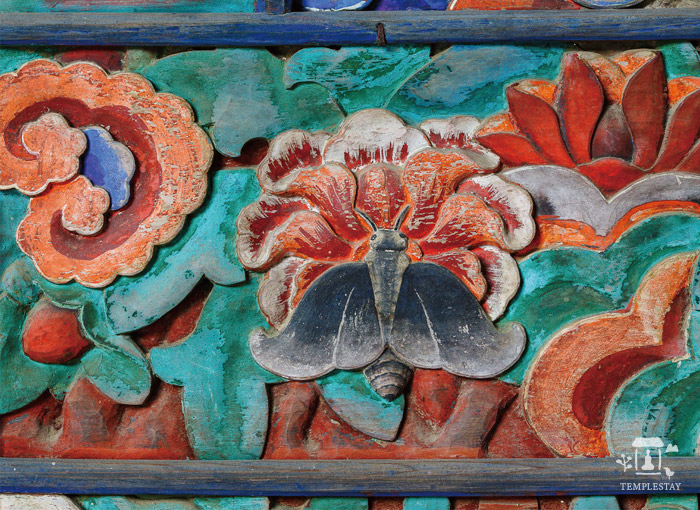 The Sumidan at Jikjisa Temple in Gimcheon.
The Sumidan at Jikjisa Temple in Gimcheon.
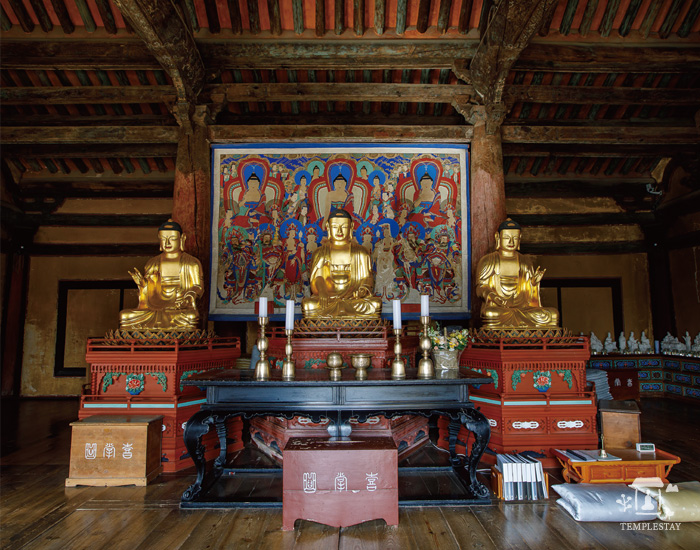 The wooden hexagonal Sumidan in Daeungjeon Hall at Sudeoksa Temple.
The wooden hexagonal Sumidan in Daeungjeon Hall at Sudeoksa Temple.
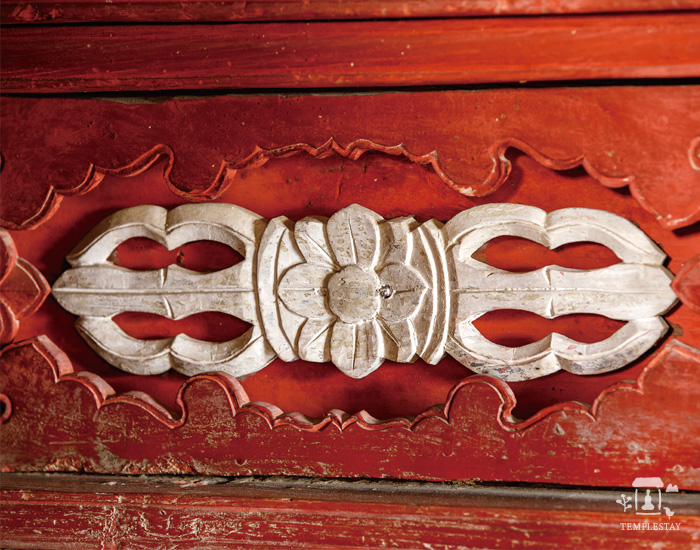 The decorative carving on the wooden Sumidan.
The decorative carving on the wooden Sumidan.
Adorning the Realm of the Buddha
Among the remaining Sumidan in Korea, the one considered the height of Buddhist sculpture is definitely the Sumidan at Baekheungam Hermitage of Eunhaesa Temple in Yeongcheon. This Sumidan was designated a “general treasure” in 1968 for its extraordinary imagery and splendid sculpture.
Geungnakjeon (Paradise Hall), where the Sumidan is installed, was also designated a “general treasure” in 1984. In other words, the Sumidan inside the buddha hall was designated a general treasure first, and the buddha hall was designated one 16 years later. To that extent, the Sumidan in Geungnakjeon Hall at Baekheungam Hermitage can be said to be the essence of Buddhist woodcraft.
A Sumidan usually has a three-level structure: lower part, middle part, and upper part. The Sumidan at Baekheungam was also crafted in this style, and a long auxiliary table was installed in front of the buddha triad on the upper part, making it a two-tiered terraced structure.
The coloring of the overall sculpture has a lot of red and dark green, giving it a serious and solemn look. By the 1700s, green was used increasingly in Buddhist paintings, and the Buddha's nimbus also changed to green. Thus, we see that the coloring of the Sumidan is also from this period.
The lower front part of a Sumidan is divided into five compartments, and each compartment is carved in the shape of a terrace. On each compartment, the faces of a dragon and a byeoksa (sacred animal who wards off evil spirits) are carved.
Some say it is the face of a goblin or the frontal image of a dragon, but there is no dispute that it plays a role in protecting the buddhas.
The middle part, considered the body of the Sumidan, is usually divided into 3 tiers: upper, middle, and lower. Each tier of Baekheungam's Sumidan is divided into 5 compartments. First, peonies in full bloom are engraved on the lower tier.
The peony is native to China and has long been called the king of flowers. Since the Goryeo era, Korean Buddhism has often depicted the Buddha and peonies side by side on Sumidan and murals. This is because the former is the king of dharma while the latter is the king of flowers. Peonies also symbolize wealth, honor, and fame, so they have been passed down for centuries as symbols of the people's wishes. Between the peonies, giraffes, dragon-horses, lions, and elephants are engraved here and there, symbolizing good fortune.
The middle tier of the middle part is decorated with lotuses, a symbol of Buddhism, and with dragons, fish, frogs, etc. engraved in between them. The child playing among the lotuses is related to the concept that sentient beings die and are reborn from lotus flowers in the Pure Land. So, the depiction of a child on the Sumidan of Geungnakjeon Hall may symbolize this concept.
Chrysanthemums are depicted at both ends of the middle tier. Lotuses and chrysanthemums were the preferred flowers of Joseon scholars. The lotus symbolizes the scholar's attitude because it is never stained by mud, and chrysanthemums bloom after all other flowers have faded, symbolizing the scholar's fidelity. In Buddhism, chrysanthemums also appear in Buddhist sculptures as a symbol of practitioners. The upper tier of the middle part features birds that can fly, both in reality and in the world of imagination.
Cranes and phoenixes fly, and peacocks and pheasants play among the flowers. Even more bizarre sculptures appear on both sides of the upper tier of the middle part. A mythological bird called the kalavinka flies away carrying a peach on a tray, and a strange figure with a turtle shell on his back walks carrying a wish-fulfilling gem. A person whose lower body is a fish and upper body is a human holds a wish-fulfilling gem, while in the background, a fish with a human head is carved holding a lotus.
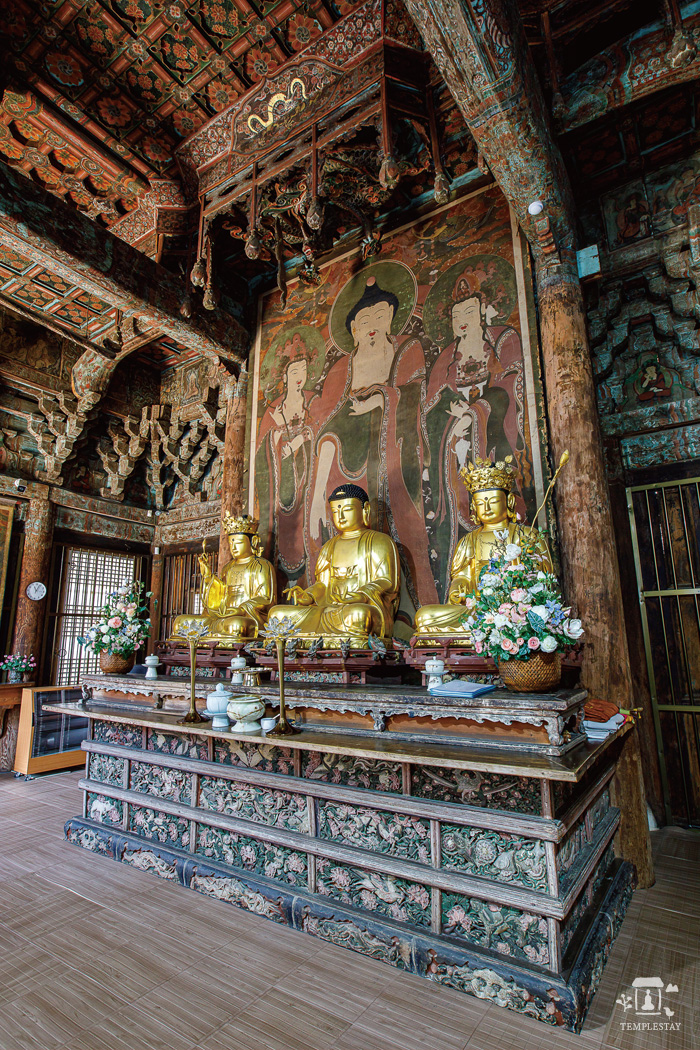 The Sumidan at Baekheungam Hermitage of Eunhaesa Temple in Yeongcheon.
The Sumidan at Baekheungam Hermitage of Eunhaesa Temple in Yeongcheon.
Baekheungam's Sumidan depicts with infinite imagination various creatures living under Mt. Sumeru. However, just because the images of sentient beings we cannot easily understand are engraved on a Sumidan does not mean they contradict the teachings of Buddhism. Since Buddhism conveys truth that is accepted in every world of the universe, it can be said to contain the message that sentient beings in other worlds can also attain buddhahood through the teachings of the Buddha.
Another Sumidan designated a general treasure is in Daeungjeon Hall at Jikjisa Temple in Gimcheon. Enshrining three buddhas, this Sumidan has a text in ink saying it was created in 1651. Measuring over 10 meters in length and in the form of a flat rectangular table, this Sumidan is the largest in Korea. Red, green, and blue are its main colors, giving an overall bright and cheerful appearance.
The middle part of this Sumidan also has three tiers, depicting mandarin fish and clams on the lower tier. The Korean name for mandarin fish is associated with palaces. In folk paintings, the picture of mandarin fish symbolizes passing the civil service examination, entering the palace, and becoming a government official.
In other words, a mandarin fish symbolizes both the wish for success and the prevention of fire (because they live in water). Since clams symbolize the prosperity of one's descendants, they are depicted on a Sumidan to prevent fires and to represent the prayers of devotees for the prosperity of their descendants.
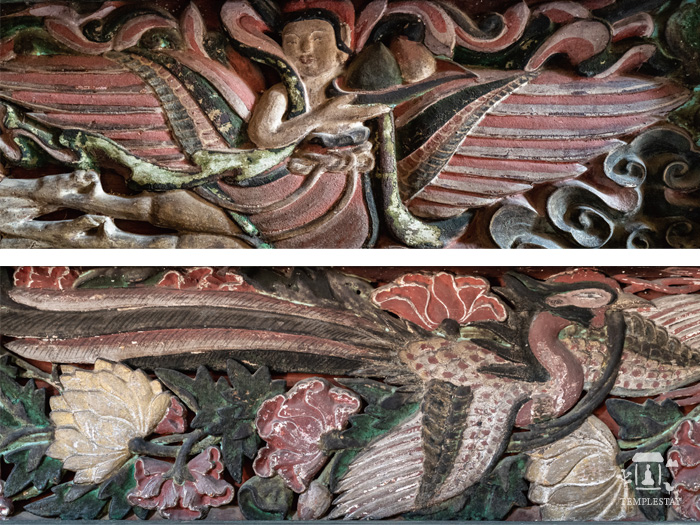 Baekheungam's Sumidan depicts with infinite imagination various creatures living under Mt. Sumeru.
Baekheungam's Sumidan depicts with infinite imagination various creatures living under Mt. Sumeru.
In the middle tier of the middle part, earthly sentient beings are depicted among lotuses and peonies. Unusually, in the first compartment on the left, the Heaven of Thirty-Three on the summit of Mt. Sumeru is carved. Since the world above this Heaven is a giant void, only a flying dragon is depicted in the upper tier of the middel part.
Butterflies and dragonflies are also seen on the middle tier. Butterflies and dragonflies go through a larval stage and pupae stage before finally becoming winged adults that can fly. In Daoism, this is likened to a person becoming an immortal, and Buddhism has also embraced this concept and used it as a symbol of attaining liberation through spiritual practice. The Sumidan in Daeungjeon Hall at Jikjisa Temple in Gimcheon is the largest and most splendid among the Sumidan altars of late Joseon, and its carvings are of the highest level.
It is a superior piece of Buddhist woodcraft from the mid-17th century, and at the same time, it proudly displays a variety of materials and patterns, bright coloring, and in-depth carving skills. That is why this Sumidan is considered one of the most beautiful, along with those at Baekheungam of Eunhaesa Temple, Daeungjeon of Beomeosa Temple, and Wontongjeon of Pagyesa Temple.
A Sumidan depicts a world inhabited by transcendental and fantasy creatures, but it also embodies a world where the reverence and joy living beings feel toward the Buddha and their hopes for everyday life are embodied in various forms of sculpture and patterns.
It is not simply a sculpture to adorn and decorate a buddha hall; it is a majestic adornment that helps sentient beings in their practice of cultivating wisdom and accumulating merits. The teachings and goals of Buddhism are subtly embedded in Sumidan. The more you look at it, the more you realize it is a valuable cultural asset.
Noh Seung-dae has devoted more than 20 years to visiting various sites and studying Korean cultural heritage with an unwavering passion for our culture. The results have been contributed to magazines like Bulkwang and People and Mountains . His Korean publications include Hidden Supporting Actors in Temples and At Temples Goblins Live and So Does Grandmother Samsin.





